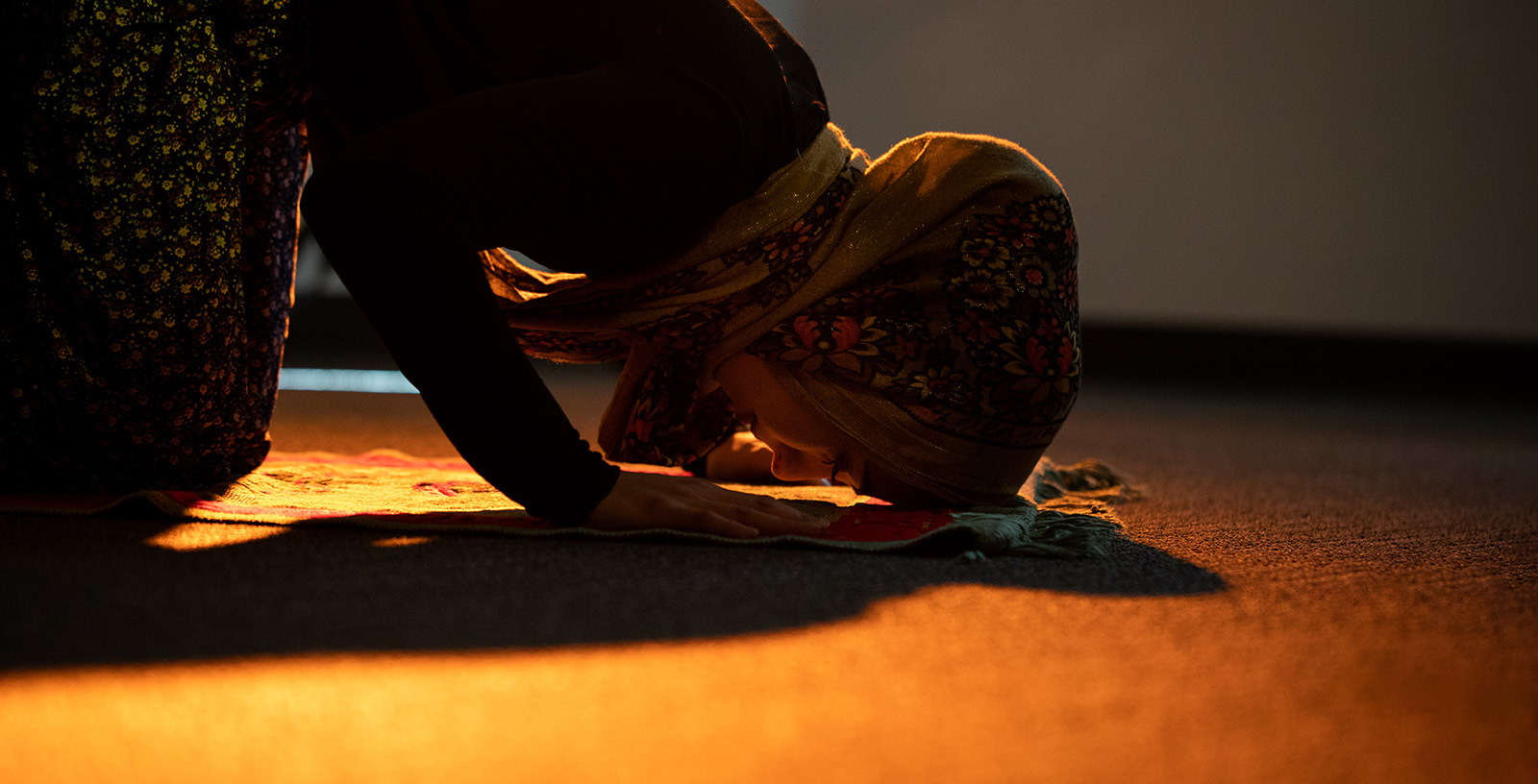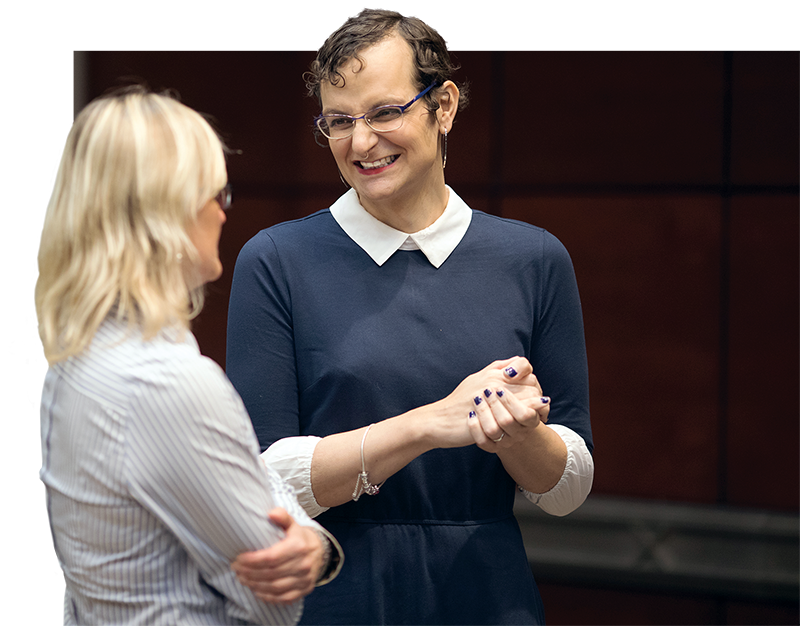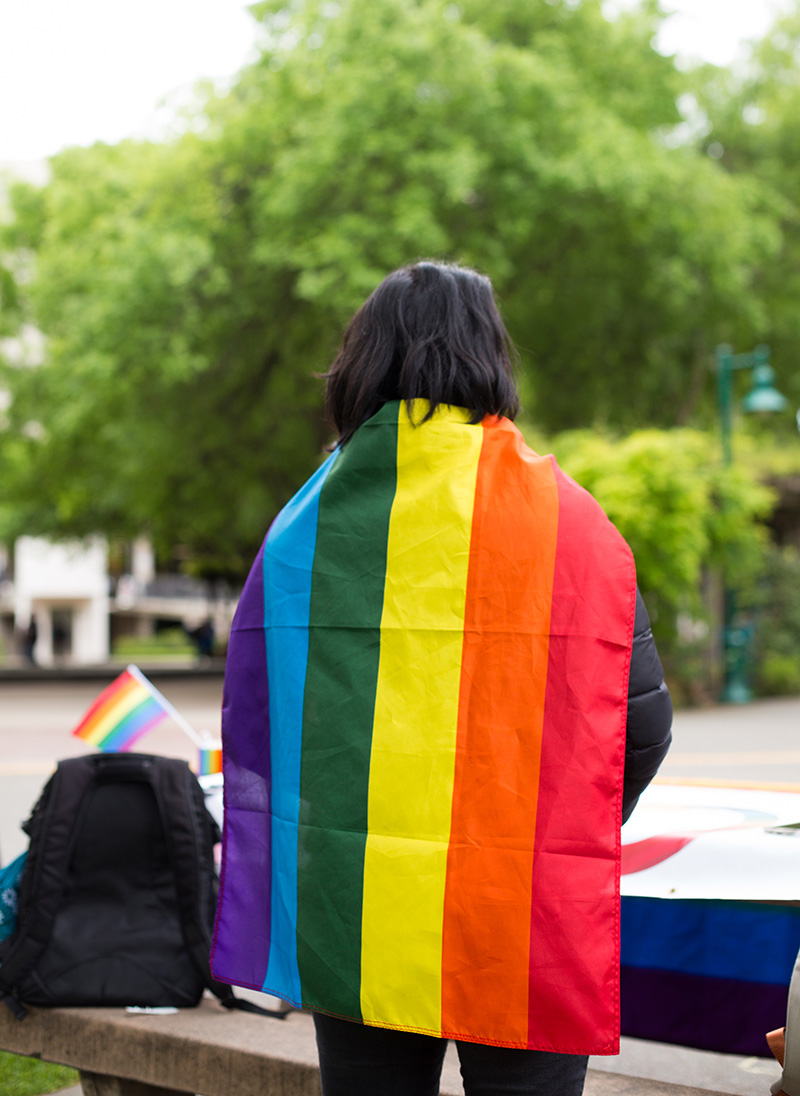

The Art of Inclusion
Progress is measured by the increasing strength of the University’s embrace
Cynthia Hubert
“It goes beyond checking a box. We’re trying to make sure everyone’s cup gets filled.”

Ántonia Peigahi, right, conversing with a colleague, found that Sac State embraced her when she made known that she was transgender, helping her “become my authentic self.” Photo by Andrea Price
Off campus, Ántonia Peigahi sometimes feels alienated and afraid. On her frequent walks, or while shopping for groceries or dining in restaurants, she has endured stares, slurs and taunts.
Her safe zone is Sacramento State, where she is an esteemed colleague and chairs the Faculty Senate.
Peigahi is a transgender woman and last year came out to her Sac State peers, who had long known her as a man named Reza. It was a terrifying prospect, she said. But she instantly felt a genuine sense of belonging and respect.
“I look at my experience, and I feel so privileged to be so embraced by the campus community,” says Peigahi, who also serves as Sac State’s education librarian. “I have been supported unequivocally. It has been a really smooth process for me to become my authentic self.”
Students who identify as LGBTQ have since reached out to thank her and share their own stories.
President Robert S. Nelsen and his administration want everyone on campus to feel that sense of worth and belonging. Changing Sac State from a diverse campus into one that is inclusive to all is one of Nelsen’s five “imperatives,” around which his leadership strategies have been fashioned. To effect that change, the University is working to determine just what an inclusive campus looks and feels like, and how such a transition – when deliberate and well-thought-out – can be accomplished.
Sac State is on the right path, administrators say, but remains far from the goal line.
“We have a long way to go,” says John Johnson, director of the campus Centers for Diversity and Inclusion.
Some students agree. More than two dozen Sac State students who responded to an Instagram query about the University’s efforts to make the campus accessible and friendly to all offered a wide range of responses and experiences.
Some said that their backgrounds, ethnicities, and beliefs make them feel like outsiders both in class and on the campus at large. Others said they have found a home at Sac State.
Ethnically, Sac State’s student population is one of the most diverse in the nation, mirroring the city’s makeup. But its faculty is largely white, statistics show.
The administration’s overall challenge is to make the campus truly inclusive to the patchwork of cultures, backgrounds, and voices that come together inside and outside of the classroom each day.
“It’s not enough to have superficial demographic compositions of race, gender, ethnicity,” says Johnson, whose unit comprises the Multi-Cultural Center, the PRIDE Center and the Women’s Resource Center. “It goes beyond checking a box. We’re trying to make sure everyone’s cup gets filled.”
Leading the effort at Sac State is the new Office of Inclusive Excellence (OIE). Its mission is to ensure that people with a wide range of identities feel valued and welcomed on campus.
Achieving that goal will require not only examining data, but continuing a dialogue with faculty members and students to determine what the University is doing correctly and where it is falling short, says Diana Tate Vermeire, vice president for Inclusive Excellence.
“We want to hear about their experiences and find ways for the campus to support them,” Vermeire says.
A spring 2018 survey of administrators, faculty, and staff revealed that nearly 80 percent of respondents believe the campus is welcoming to whites, but far fewer believe that embrace is extended to other groups, particularly African Americans.

Support for Sac State’s LGBTQ communities is made known through places such as the PRIDE Center, as well as through individual expression. Photo by Jessica Vernone
Faculty makeup, especially, is being scrutinized
“We need to look at our faculty search processes,” Vermeire says. “How do we recruit? Where do we look? What do we look for? How do we seek to retain faculty members? This is the first time that the University is looking at these things institutionally.”
Knowing the ethnicity, race, and gender of the campus community is essential, Vermeire says, but to really know what characterizes the University’s population, recognition and acknowledgement of gender identity, sexual orientation, religious background, and disabilities is required.
“People from different backgrounds bring different identities to the table,” she says.
Sac State’s student body is a “majority minority,” – whites are the largest single racial group, but they are outnumbered by the combination of minorities on campus – while 65 percent of its faculty members in fall 2018 were white. About 12 percent of faculty were Asian, 5 percent African American, and 7 percent Latino.
Vermeire says her office needs to dig deeper into the numbers and backgrounds of its population and consider whether they reflect the diversity and inclusivity that the University is striving to achieve.
“We can say we’re an inclusive campus,” she says, “but if the three to 10 people that students interact with every day in the classroom, in the library, at events, don’t make them feel as though they belong, then that’s not inclusive.”
The University has used various outreach efforts to recruit more students from groups that are underrepresented on campus. Its “Super Sunday” event at traditionally black area churches, for example, seeks to attract more black youth.
Last fall, blacks represented just 6 percent of the student body, and progress has been slow. Specifically, the percentage of African American students at Sac State has been declining for the past decade, a trend present throughout the CSU system.
Sac State’s All In Recreation program, which allows students with and without disabilities to participate in adaptive sports programs, illustrates the University’s efforts toward inclusion and its failures to fully accomplish it.
The program, one of the most comprehensive on the West Coast, has difficulty attracting disabled students, says student supervisor Alexis Egerer.
“People with disabilities grew up thinking that they can’t do things like this,” Egerer says while watching players in athletic wheelchairs battle one another on the court at The WELL. “So
they are nervous. There definitely is value in the experience for students who are disabled and students who are not, so I wish more people with disabilities felt comfortable participating.”
Biology student Alfonso Barraza participates in wheelchair basketball games every Friday even though he has no physical disabilities. “It’s the best part of my week,” he says.
Barraza plays, he says, because he enjoys the game and the social interaction, but also because it gives him an inkling of what it might be like to navigate the world from a wheelchair.
“Obviously I can’t know what that is like completely,” Barraza says. “But it’s a step.”
Other students say participation in campus organizations and activities has helped them feel empowered and embraced by the University.
Makayla Fleisher, a Recreation, Parks and Tourism Administration major, says she is a former foster child who for much of her life felt a deep sense of isolation. Since coming to Sac State from junior college, she has joined the Recreation Majors Association and the Guardian Scholars Program. Participation in those groups has given her a sense of unity with others on campus.
“As a former foster kid, I have never before had a community of people who can relate to my past trials in the system,” she says. Now she feels free to share painful stories of her past. “I have also found a place I can come to do homework as well as laugh with my friends.”
Reem Muharam, who is majoring in Child Development, says her Middle Eastern heritage and dress made her feel “different from everyone else” at her high school in the tiny town of Arbuckle. Everything changed last year when she transferred from Yuba College to Sac State.
“Here, I feel completely comfortable,” she says. “I can walk on campus and not feel ashamed of who I am. I walk with my head held high. I smile at everyone, and they smile back at me.”
Within the Muslim Student Association, Muharam interacts with others who share her cultural background and religious beliefs.
Sac State boasts many groups and projects dedicated to serving people with varying backgrounds and experiences.
Its Full Circle Project supports students who identify as Asian American or Pacific Islander. The Martin Luther King Jr. Center is focused on African American students. The Serna Center serves Latinos. The campus has programs for LGBTQ people, undocumented families, veterans, and others. The newly expanded University Union features a Meditation Room with an adjacent foot washing station for Muslim students, faculty members, and staff who want a quiet place to say their daily prayers.
Those efforts are important, Johnson says, but inclusivity means more than providing people with individual comfort zones where they can spend time with others who look and think like them.
“We don’t want just to create silos, hubs, or safe havens,” he says. “We don’t simply want to tend to the oasis. We are dealing with the entire desert.”
One example of the administration’s efforts to demonstrate its commitment to the issue came in March, following the Sacramento County district attorney’s decision to clear police officers of criminal responsibility in the killing of Stephon Clark, an unarmed black man shot to death in Meadowview nearly
a year earlier.
With tensions high in the aftermath of DA Anne Marie Schubert’s announcement, the University reached out to students and others on campus who were deeply affected by the case. President Nelsen used his Spring Address to talk about the issue, and dancers and other performers offered various perspectives through their art. When the administration learned of a student walkout related to the Clark killing, it urged faculty members to be understanding of the demonstration’s participants.
“We are proud that our students exercised their free speech rights,” Vermeire says. “And we are listening.”
Perhaps the best illustrations of what true inclusion looks like on campus, says Johnson and others, are informal and sometimes spontaneous: protests, lunch gatherings, and social interactions at residence halls.
When members of the Westboro Baptist Church – which is based in Kansas, is virulently anti-gay, and is known for its use of inflammatory hate speech – visited campus last summer, students, faculty, and staff members of all backgrounds and gender identities came together to support the LGBTQ community.
Peigahi’s personal moment of inclusion occurred in August, as she prepared to appear before hundreds of her colleagues for the first time as a woman. Her task was to introduce Nelsen prior to his Fall Address.
“Before the event, I was so fearful,” she says. “I walked around campus, and I asked myself what might happen. These were people I cared about and respected. I didn’t want them to think this was a stunt. I didn’t want to embarrass the president. I just wasn’t sure how it would go.”
Stepping up to the microphone, she tried to break the ice. “For those who have not seen me in a while,” she said, smiling, “I am Ántonia Peigahi, Faculty Senate chair.”
The cheers began before she finished her sentence.
“When I heard that applause, it really resonated,” she says. “It was so powerful. I can now walk the halls without fear, and contribute to the University with even more vibrancy and energy and love than I did before. The inclusivity that we are creating, it changes lives.
“There is a joy in knowing that you are included in the life of an organization like Sacramento State, that we are all a part of something bigger than ourselves.”
Inclusion. Are you feeling it?
John Johnson
Director of Centers for Diversity and Inclusion: “Students from certain backgrounds and identities need to feel that their culture and intellectual heritage are represented, and are a valued part of the University culture.”
Shelby Lynn Woodring
Deaf Studies major: “In the future, I hope Sac State makes sure students who are not from the area feel like they are part of the community by hosting social events or encouraging them to join clubs, not just during the first few weeks but throughout the semester.”
Makayla Fleisher
Recreation Parks Tourism Administration major: “My advice for those who want to feel more comfortable and included on campus is to try anything you might like. Try and fail because you will learn what you like and what you don’t. The best things in life are on the other side of fear.”
Reem Muhuram
Child Development major: “Coming here as a transfer student from Yuba College, I saw people who looked like me. It built my confidence.”
Alfonso Barraza
Biology major: Barazza is able bodied, but plays wheelchair basketball each week at The WELL to get an inkling of what it is like to have a disability. “Obviously I can’t know what that is like completely. But it’s a step.”
Antonia Peigahi
Chair of the Sac State Faculty Senate and Education Librarian: “When I come to work, I’m in a safe place that respects diversity and inclusion. It’s not just words here. It’s action.”